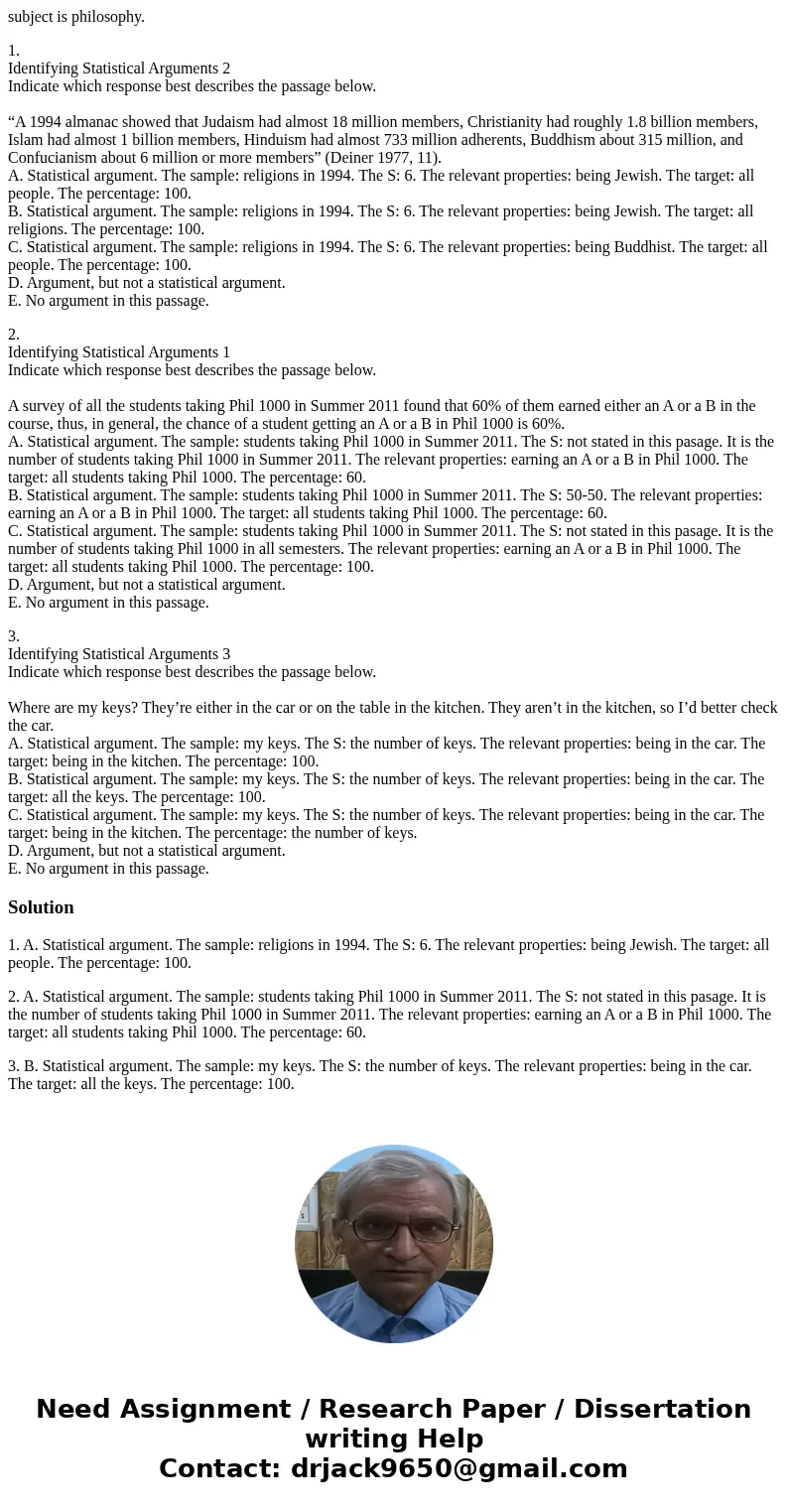subject is philosophy 1 Identifying Statistical Arguments 2
subject is philosophy.
1.
Identifying Statistical Arguments 2
Indicate which response best describes the passage below.
“A 1994 almanac showed that Judaism had almost 18 million members, Christianity had roughly 1.8 billion members, Islam had almost 1 billion members, Hinduism had almost 733 million adherents, Buddhism about 315 million, and Confucianism about 6 million or more members” (Deiner 1977, 11).
A. Statistical argument. The sample: religions in 1994. The S: 6. The relevant properties: being Jewish. The target: all people. The percentage: 100.
B. Statistical argument. The sample: religions in 1994. The S: 6. The relevant properties: being Jewish. The target: all religions. The percentage: 100.
C. Statistical argument. The sample: religions in 1994. The S: 6. The relevant properties: being Buddhist. The target: all people. The percentage: 100.
D. Argument, but not a statistical argument.
E. No argument in this passage.
2.
Identifying Statistical Arguments 1
Indicate which response best describes the passage below.
A survey of all the students taking Phil 1000 in Summer 2011 found that 60% of them earned either an A or a B in the course, thus, in general, the chance of a student getting an A or a B in Phil 1000 is 60%.
A. Statistical argument. The sample: students taking Phil 1000 in Summer 2011. The S: not stated in this pasage. It is the number of students taking Phil 1000 in Summer 2011. The relevant properties: earning an A or a B in Phil 1000. The target: all students taking Phil 1000. The percentage: 60.
B. Statistical argument. The sample: students taking Phil 1000 in Summer 2011. The S: 50-50. The relevant properties: earning an A or a B in Phil 1000. The target: all students taking Phil 1000. The percentage: 60.
C. Statistical argument. The sample: students taking Phil 1000 in Summer 2011. The S: not stated in this pasage. It is the number of students taking Phil 1000 in all semesters. The relevant properties: earning an A or a B in Phil 1000. The target: all students taking Phil 1000. The percentage: 100.
D. Argument, but not a statistical argument.
E. No argument in this passage.
3.
Identifying Statistical Arguments 3
Indicate which response best describes the passage below.
Where are my keys? They’re either in the car or on the table in the kitchen. They aren’t in the kitchen, so I’d better check the car.
A. Statistical argument. The sample: my keys. The S: the number of keys. The relevant properties: being in the car. The target: being in the kitchen. The percentage: 100.
B. Statistical argument. The sample: my keys. The S: the number of keys. The relevant properties: being in the car. The target: all the keys. The percentage: 100.
C. Statistical argument. The sample: my keys. The S: the number of keys. The relevant properties: being in the car. The target: being in the kitchen. The percentage: the number of keys.
D. Argument, but not a statistical argument.
E. No argument in this passage.
Solution
1. A. Statistical argument. The sample: religions in 1994. The S: 6. The relevant properties: being Jewish. The target: all people. The percentage: 100.
2. A. Statistical argument. The sample: students taking Phil 1000 in Summer 2011. The S: not stated in this pasage. It is the number of students taking Phil 1000 in Summer 2011. The relevant properties: earning an A or a B in Phil 1000. The target: all students taking Phil 1000. The percentage: 60.
3. B. Statistical argument. The sample: my keys. The S: the number of keys. The relevant properties: being in the car. The target: all the keys. The percentage: 100.

 Homework Sourse
Homework Sourse